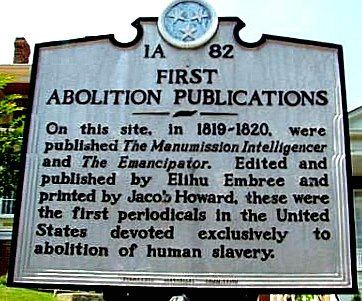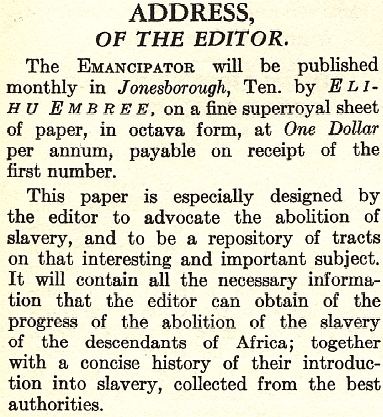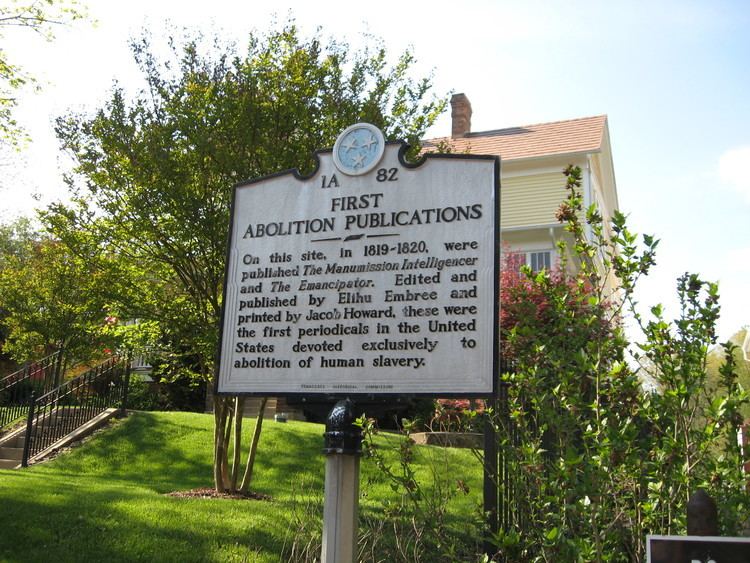Name Elihu Embree | ||
 | ||
Died December 4, 1820, Jonesborough, Tennessee, United States | ||
Elihu Embree's Emancipator by Sophie Crum
Elihu Embree (November 11, 1782 – December 4, 1820) was an abolitionist and the publisher of the first newspaper in the United States devoted exclusively to the cause of abolishing slavery.
Contents
- Elihu Embrees Emancipator by Sophie Crum
- Elihu Embree and the Emapancipator by Adrienne Bangham
- Early life
- Business activities
- Publishing career
- References

Elihu Embree and the Emapancipator by Adrienne Bangham
Early life

Embree was the son of a Quaker minister who moved from Pennsylvania to Washington County in East Tennessee around 1790. It is not known where he attended school, although some accounts suggest he was taught by the famous Presbyterian minister, Samuel Doak, at Washington College Academy.
Business activities

Elihu Embree was involved in the iron manufacturing business with his brother, Elijah. Elijah married the granddaughter of the famous governor, John Sevier, and at the time of his death in 1846 was the owner of 70,000 acres (280 km²) of mineral-rich land valued at nearly one million dollars. Elihu, however, being somewhat visionary and impractical in his plans, was a poor business manager. During his early life he owned slaves, having purchased several and having come into possession of a number of others through his wife. Around 1812, however, he freed all of them, at a considerable financial sacrifice; soon afterward he became an ardent anti-slavery advocate, and remained so until his death.
Publishing career
In 1819, after securing the approval and cooperation of the Manumission Society of Tennessee, of which he was an active member, Embree began the publication of a weekly anti-slavery paper at Jonesborough, Tennessee under the name of the Manumission Intelligencer, the first issue of which appeared in March. Very little is known concerning this paper. Of the fifty or more issues that were published, less than a dozen copies are known to have survived to the twentieth century.
In April, 1820, the paper switched from a weekly to a monthly format and changed its name to The Emancipator, though it remained under the same editorship. The object of the paper as set forth in an address to the general public in the first issue was to "advocate the abolition of slavery, and to be a repository of tracts on that interesting and important subject." In the paper, slavery and slaveholders were condemned in the strongest terms, and the evils of the system of slavery were forcefully pointed out.
Despite being an outspoken abolition paper published in a slave state, The Emancipator achieved remarkable popularity. At the time of Embree's early death it could boast of 2,000 paying subscribers, which was probably as large as that of any newspaper in either Tennessee or Kentucky. This was likely due to the strong anti-slavery sentiment that prevailed in East Tennessee at the time. On the other hand, the paper also encountered considerable opposition, both from those who supported slavery and those who condemned anti-slavery agitation. The Emancipator had an existence of only eight months due to the death of Embree, aged 38, on December 4, 1820, from "bilious fever". A full collection of the journal, comprising one hundred and twelve pages, was reprinted in 1932 by B. H. Murphy. In 1974, the Tennessee legislature honored the memory of Elihu Embree for his work on behalf of the "universal and equal liberty of all men".
